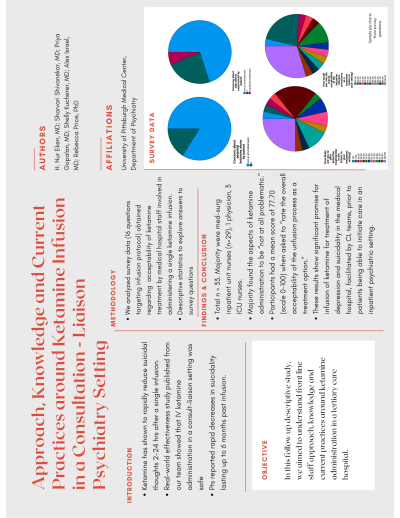Suicidality and Behavioral Emergencies
(180) Approach, Knowledge and Current Practices around Ketamine Infusion in a Consultation-Liaison Psychiatry Setting


H. Nur Eken, MD (she/her/hers)
Resident Physician
Department of Psychiatry
Pittsburgh, Pennsylvania
Sharvari Shivanekar, M.D.
Assistant Professor of Psychiatry
University of Pittsburgh
Pittsburgh, Pennsylvania.png)
Priya Gopalan, MD FACLP
Associate Professor
University of Pittsburgh Medical Center, Western Psychiatric Hospital
Pittsburgh, Pennsylvania
Shelly Kucherer, MD
Assistant Professor of Psychiatry
University of Pittsburgh School of Medicine
Pittsburgh, Pennsylvania- AI
Alex Israel, MD
Assistant Professor of Psychiatry
University of Pittsburgh
PIttsburgh, Pennsylvania - RP
Rebecca Price, PhD
Associate Professor
Department of Psychiatry
Pittsburgh, Pennsylvania
Presenting Author(s)
Co-Author(s)
Implications: Future studies should investigate approach and current practices around ketamine administration for other providers involved, including those in the primary teams and CL psychiatry teams. References 1- Shivanekar, S., Gopalan, P., Pizon, A., Spotts, C., Cruz, N., Lightfoot, M., ... & Price, R. (2022). A pilot study of ketamine infusion after suicide attempt: new frontiers in treating acute suicidality in a real-world medical setting. International journal of environmental research and public health, 19(21), 13792.
Background: Ketamine has shown to rapidly reduce suicidal thoughts 2–24 h after a single infusion in patients, which can be maintained up to 90 days after infusion [1]. An open-label real-world effectiveness study published from our research team suggested that intravenous ketamine administration in a consultation-liaison setting was safe, feasible, and that patients reported rapid, statistically significant decreases in suicidality and depression starting 24-hours after infusion, with improvements from baseline maintained up to 6 months past infusion [1]. In this follow-up descriptive study, we aimed to understand front line staff approach, knowledge and current practices around ketamine administration in a tertiary care hospital.
Methods: We analyzed survey data obtained regarding acceptability of ketamine treatment by medical hospital staff who had been involved in administering a single ketamine infusion on their floor as part of an effectiveness research study. Survey questions included monitoring vitals during ketamine administration, monitoring of psychiatric symptoms during/after infusion, knowing how to properly handle/waste ketamine, concerns about side effects experienced by patients, and others. We used descriptive statistics to explore answers to survey questions given to providers who were involved in ketamine treatment.
Results: Of the 33 people who filled out the survey, the majority were medical-surgical inpatient unit nurses (n=29, 87.9%), 1 was a physician (3%) and 3 (9.1%) were ICU nurses. The majority of participants found the aspects of ketamine administration, as listed on the survey questions, to be “not at all problematic”. On a scale from 0 to 100, participants had an average score of 77.70 when they were asked to “rate the overall acceptability of the ketamine infusion process as a treatment option in your setting.”
Discussion: Overall, majority of the participants in the ketamine administration protocol reported finding several aspects of the research protocol for ketamine infusion to be not at all problematic, and rated the acceptability of ketamine infusion highly. These results show feasibility and significant promise for infusion of ketamine for treatment of depression and suicidality in the medical hospital, facilitated by the consultation-liaison psychiatry teams, prior to patients being able to initiate care in an inpatient psychiatric setting.
Presentation Eligibility: Not previously published or presented
Diversity, Equity, and Inclusion: Thus far studies investigating ketamine infusion for suicidality largely had strict inclusion criteria. The larger research protocol that our study derives from has a broader inclusion criteria, including individuals suffering from substance use disorders thus representing a sample closer to actual populations at risk of suicidal thoughts and behaviors. Furthermore, by investigating acceptability of ketamine treatment by hospital staff, we are aiming to advance treatment of behavioral emergencies more effectively for a larger patient population in a CL setting.

